Media | Articles
Avoidable Contact #106: What this Tempo can teach us about the Porsche 968

What is joy? Would you believe that it is this: Two weeks ago, on the leafy and uncluttered streets of a fascinating Houston neighborhood dotted with mid-century homes, I had the chance to drive an outstanding in-progress restoration of a truly rare sporting automobile. No, I’m not talking about those garden-variety supercars or Sixties muscle cars. I’m not even referring to the Ferrari 250 GTO. Anybody with the right Rolodex and a little bit of charm can put five GTOs on a lawn somewhere pronto … but under what circumstances could you assemble five Ford Tempo GLS five-speed sedans? The 1992 build numbers are in the McLaren 675LT range, with about 800 cars produced across coupe and sedan body styles, but after twenty-nine years of neglect, decay, and clunker cash I cannot think that a dozen of them remain. The Internet, to the best of my knowledge, is aware of just three in running condition: one coupe and two sedans.
Oh, and restoring a 250 GTO is child’s play compared to putting a Tempo GLS together. Nearly every component of a Sixties Ferrari can be had from a number of suppliers including Ferrari itself, but if you can’t find it you can always make it, because the processes used to make a Ferrari back then can all be replicated by a competent, albeit expensive, workshop. Not so with the Tempo. It’s littered with injection-molded and other plastic items that simply no longer exist, using technologies that have become obsolete. The unique front and rear bumper? What would it cost to have a new pair of molds made for them? It wasn’t cheap when Ford was doing it. I suppose you could 3D print it in sections, glue those sections together, then apply an external finish to simulate the original plastic. Maybe.
Perhaps a better question is: Why bother? It’s obvious why people choose to restore Ferrari 250 GTOs or Hemi Road Runners, but the case for doing so with a Ford Tempo, even the 1992 five-speed GLS sedan that was called “the poor man’s SHO” on its debut and has since gone on to be recognized as the ultimate and most desirable example of the model—save your angry comments, AWD five-speed Topaz owners—is a little less clear. Would it help if I explained that this car occupies about the same space in some people’s heads that the Porsche 968 does in the heads of others? No?
Well, it’s all about context.
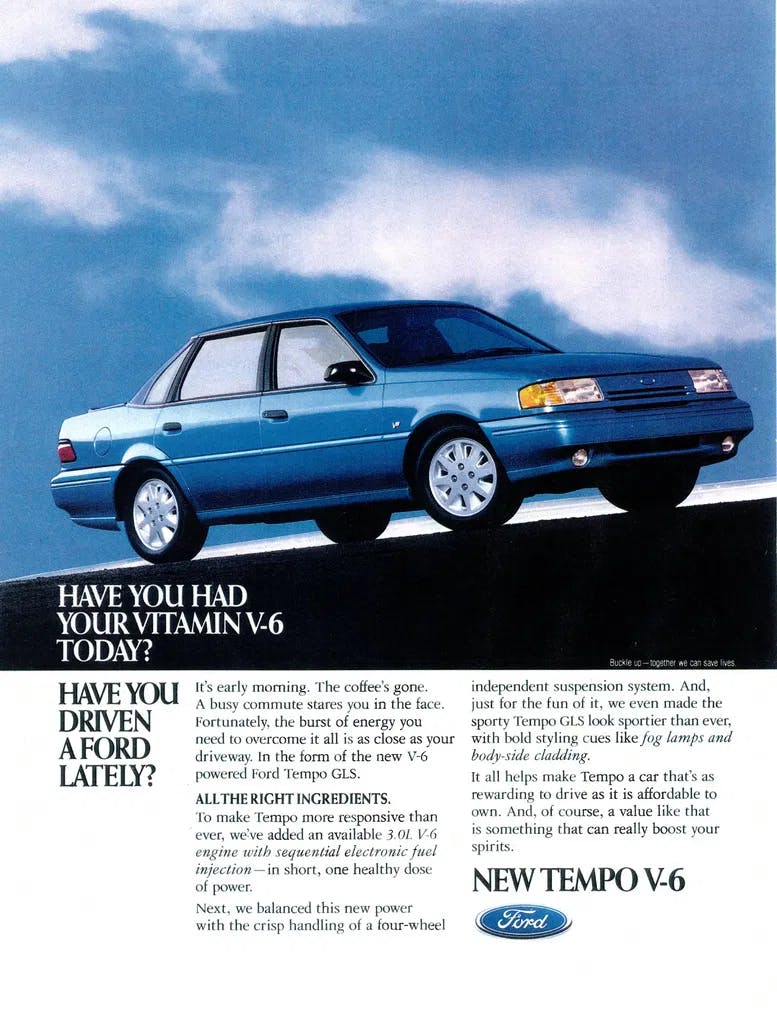
The Tempo arrived to market for the 1984 model year with a palpable whiff of age on it; the bones of it had been circulating the country for three years already, in the form of the 1981 Escort. Happily, the aerodynamic styling was new, coherent, and even attractive in a chunky sort of way. Compared to the Honda Accord of the era, however, the Tempo didn’t quite measure up. It was narrow, slow, and prone to a variety of quality complaints. Let’s take a look at the 1983 Accord:
Marketplace
Buy and sell classics with confidence
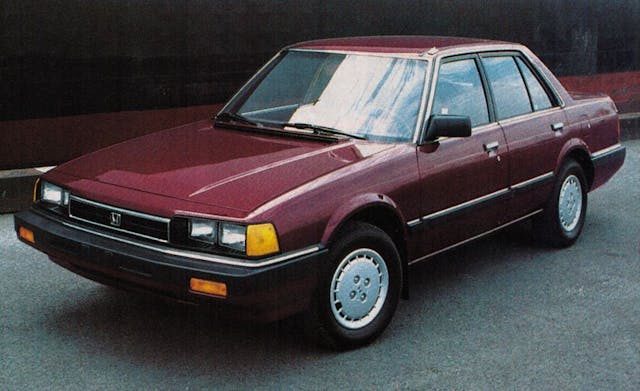
Eight years later, in 1992, this was the Accord:

The difference between the two Hondas is obvious here but it is astounding when you see them together in real life, even if you’re aware of the hidden-headlight model that covered four years’ worth of time between the pair. The Tempo, on the other hand? Well, it had barely changed. The sedans had gotten a nifty Sable-esque roofline, and a second attempt to integrate “aero” headlamps into the front fascia had gone better than the first, but the 1984 Tempo owner who walked into a Ford showroom during the Clinton Administration wouldn’t see anything to make him experience future shock, to put it mildly.
There was one nifty mechanical difference, in the form of the Taurus “Vulcan” V-6 sitting between the front wheels of certain Tempo models. This unambitious but durable powertrain could kick out 130 horsepower from 3.0 liters. Unfortunately, the 1992 Accord could give you 140 horses from 2.2 liters, and save you some gas along the way.
Ford had a better idea coming, in the form of the global “Mondeo” sedan that would appear in our country as the Contour, but that better idea wouldn’t arrive until 1994, just in time to get curb-stomped by yet another new Accord. The 1992 Tempo, basically a 1981 Escort with a V-6 and a longer wheelbase, would just have to do the job until then.
That’s your historical context for the 1992 Tempo GLS V-6 five-speed. Don’t get the impression that nobody bought the Tempo or its Topaz sibling. They sold pretty well, mostly because they were cheap and because by then the bugs were all worked out. I sold my mother a new Topaz GS five-speed coupe in 1993, and it gave her ninety thousand miles of trouble-free service over the course of eight years. Don’t fall prey to the misinformation spread on some “classic” sites about the Tempo and Topaz. They weren’t trash, or junk, or cynical exploitations of a lumpenprole domestic market. They were perfectly decent vehicles. But they weren’t competitive, in context.
Now, I want you to imagine with me that the Tempo was based not on a 1981 predecessor but on a 1976 predecessor. The rest of the story we can leave the same, pretty much: we pull the two-liter-ish engine out and put in a three-liter, we swap on some new headlights, we offer new colors, and we keep selling the car in 1992. Does that sound familiar?
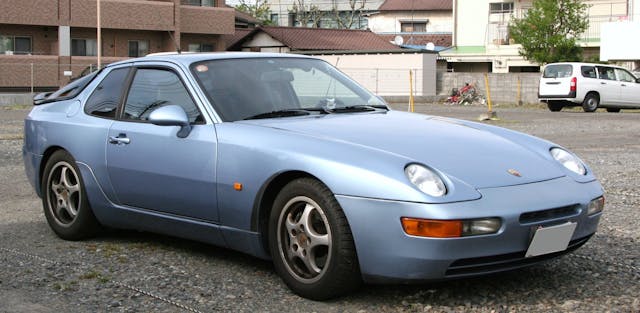
The Porsche 968 was just a Porsche 924 with two decades’ worth of detail improvements and a clunky engine that didn’t make enough power to hang with the Japanese competition—or with the Corvette, for that matter. The difference between a 1976 Corvette and a 1992 Corvette is astounding, but the difference between a two-liter 924 and a three-liter 968 is, ahem, less so.
Like the Tempo GLS V-6 five-speed, the Porsche 968 got stomped in the marketplace. It would eventually disappear in favor of the Boxster, which would also get stomped by every Corvette it ever came across, and so on, until the end of time, Amen. And that is the context for the Porsche 968.
Alright. That was 1992. What’s today’s context for these cars? Why, it’s completely different. The young fellow who is restoring that Texas GLS wasn’t choosing between that and the restoration of a 1992 Accord. He’s what we used to call a “Ford man”, as is Sajeev Mehta, our Community Manager and the person who obtained my test drive for me. Sajeev is in the process of restoring a Valentino Edition Lincoln Continental, the so-called “Fox Continental”. I assure you that Sajeev did not also contemplate the restoration of a similar-vintage Acura Legend. The market for a new car is flat, competitive, price-oriented, and often driven by what Pascal called “external circumstances”; the classic-car market operates in the ventricles of the heart, where logic does not apply.
Was the 968 a little (or, let’s be real, a lot) slower than the LS1 Corvette, the same way that a Tempo GLS would probably struggle to hang with an Accord EX? Who cares now, when a family crossover can drop them both? Would your neighbors have sniffed a bit at the presence of a Tempo in their Accord-and-Camry West Coast neighborhood? I assure you that all 1992 sedans of all stripes will upset them equally in the present day.
The people who buy Porsche 968s today are doing so because it’s a special car. Nearly every 924 and 944 was actually made by Audi, but the 968 was a Stuttgart production, and could be painted to sample. It’s the nicest 924 variant to drive on a daily basis, even if it’s lacking some of that 1989 944 Turbo S Silver Rose vibe. The car looked like a pastiche when it was released but now it has a separate visual identity, particularly from the front. Right now, the demand for good 968s exceeds supply, and prices are on the rise. I can get you three LT1 Vettes for the price of the 968. All of them will slaughter the poky, porky Porsche on a road course, autocross, or street drag. Nobody cares any more.
Similarly, the myriad failures of the V-6 Tempo in comparison to the Accord no longer carry much weight with anyone. There is a small but enthusiastic group of Tempo/Topaz collectors out there. They like the aero styling, the unified interior and exterior design, the tidy proportions of the thing. Even today, the GLS I drove in Houston was a joy to operate. It always had enough power, the exterior visibility was sublime. It disappeared around you the way a decent car can.
John Mayer’s guitar instructor, a wonderful man named Tomo Fujita, likes to tell his students that “Comparison is the thief of joy”, a quote originally attributed to Teddy Roosevelt. As a perpetually struggling guitarist, I take a lot of comfort in those words, but I think there’s a second meaning to be gleaned from them. Our immediate experience of any particular moment in time is often fraught with conflict, fear, competition, and concern. In the years afterwards much of that fades and ferments into: satisfaction, appreciation, even joy. I can easily remember 1992, if I choose, as a tough year. Ford Credit didn’t pay me a lot, I was perpetually behind on my bills, and I was deeply but distantly in love with a willowy blonde who would eventually forget about me entirely and become a Vice President of Information Technology at a leading provider of financial solutions to 70 percent of the Fortune 500, not that I’ve looked her up lately or anything.
After three decades’ worth of reflection, however, I can take pleasure in much of what happened back then. I helped a lot of people get into decent cars, and I hope those cars gave them good service. I had good friends. I was healthy. Like this 1992 Tempo, I have managed to survive the time since then and now. A little worse for wear, but still ready to do what is asked of me, when it is asked. The rapper Pusha T, who like me is facing his forties with a little less dignity than one might hope, recently wrote that he was
Already aligned with the greats, and on that same note
The only ones I chase are two ghosts
For me, those ghosts are LJK Setright and Gordon Baxter. Perhaps I’m a Tempo where they were Accords, or an awkwardly styled 968 where they are sleek Corvettes. It’s alright. Just have to keep working at it, once a week until my time is up. In the meantime, I try not to compare myself with them; it’s the thief of joy.

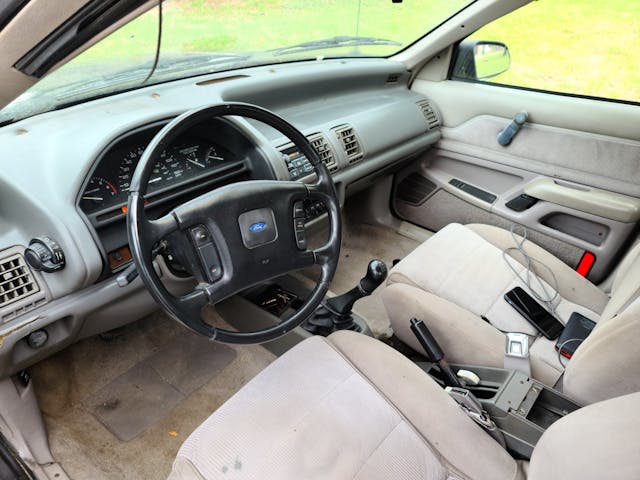
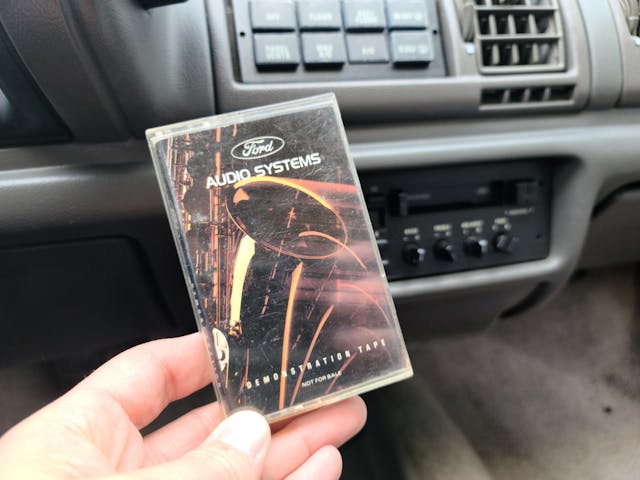








I owned a 1990 Tempo for 20 years and over 180000 miles. No it wasn’t a Porsche abd wasn’t looking for one. What it was is a simple car that took me to work, vacations with a degree of comfort and utility (and one of the most creative dashboards ever). I maintained ot routinely and had few problems, mostly a broken A/C every summer. It was the best car I owned for the simple reason it delivered what was promised, a car for typical drivers – decent room, gas mileage, safety, decent handling (yes) and utility. I don’t drive the Autobahn, I drive the BQE and don’t listen to fawning, cloying import biased journalists either. Maybe I was lucky, maybe not with mine. But it was the easiest car I ever owned…